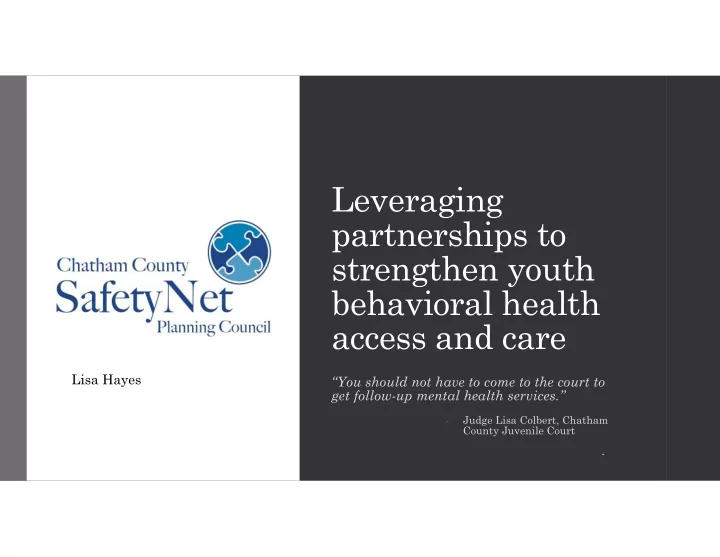

Leveraging partnerships to strengthen youth behavioral health access and care Lisa Hayes “You should not have to come to the court to get follow-up mental health services.” Judge Lisa Colbert, Chatham - County Juvenile Court -
Chatham County, GA • Total Population: 290,501 Percent less than age 18: 22% White: 54% Community Challenges: - Duplication of services African American: 41 % - Lack of coordinated efforts - Lack of trust • Poverty: 17.2% of population lives in poverty - High competition - Silos • East and West neighborhoods - Systemic Racial and Economic Inequalities 60-80% African American 30-50% have incomes BELOW the FPL High school graduation rate as low as 30% • Crime High levels of exposure to community and family violence 488 violent crimes per 100,000 inhabitants (2016)
Chatham County Safety Net Planning Council Mission : The mission of Chatham County Safety Net Planning Council (Safety Net) is to develop an infrastructure to maximize access and utilization of affordable health services and to leverage available resources to assure improved health status for our Chatham County residents. • Key Programs and Projects : Evaluation Health Information Exchange Children’s Health Insurance Community Suicide Prevention Behavioral Health Capacity Building Multi Agency Resource Center (MARC) Homeless Care Collaborative
Safety Net as a data connector: Health Information Exchange • Behavioral health • Jail • Indigent care • HIV+ • Street medicine clinics Safety Net is using data sharing to provide continuity of care for vulnerable and uninsured or underinsured populations to increase access to and quality of health and behavioral health care
Safety Net behavioral health work Prevent Suicide Evaluating Behavioral Today Health Systems (Systems barriers, gaps and recommendations) Connecting Data Sharing Focus on high Providers and risk youth & Consumers families
Chatham County Juvenile Court: CHINS Children in Need of Services (CHINS) Youth in violation of a law that is applicable only to a child. E.g., : CHINS Referrals by Age, Race & • truancy, Gender • running away from home, • curfew violation, and 2017 2016 • being habitually disobedient of the reasonable and 180 lawful commands of one’s parents . 160 171 140 120 125 125 119 100 80 60 55 42 40 36 36 10 20 8 9 9 0 Black Males Black White Males White Other Males Other Females Females Females
Working Across Silos for Youth Centered Care Partners Multi-Agency Resource Center Juvenile Court Police (MARC) for juvenile justice and multi- County government Behavioral Health state system involved youth and their families City government contracted provider Department of Family Safety Net (Neutral Designed to keep kids out of the justice and Children Services Convener) Public School System Other Community system Organizations
Using collaboration in our community: Learning from others • RWJF Invest Health / National League of Cities - Fostered Common Vision • Multiple Site Visits – See what works and what we can adapt to local needs Calcasieu Parish, LA Brooklyn Community Justice Centers – Red Hook & Brownsville The Harbor, Clark County, NV • Georgetown Center for Juvenile Justice TTA Grant - Accountability to deliverables • Community Catalyst • Carter Center • Georgia State
Using collaboration in our community: Opportunities MARC as a laboratory to address larger community needs for health, behavioral health, and Social Determinants of Health (SDoH) • Working with the existing system to connect consumers to care & systems change • Collaborating and supporting behavioral health providers • Quantifying barriers and gaps in behavioral health care (currently qualitative data) • Improve coordination for multi-system involved youth • Addressing SDoH through No Wrong Door policies, data-sharing, and collaboration
Key Collaboration Lessons Learned Degree of partnership integration Close Collaboration Coordination Cooperation Shared information Shared information Shared information Common Purpose Common Purpose Common Purpose Aligned Efforts Aligned Efforts Common Team
Thank you & questions • Lisa Hayes 678.358.8847 lisahayes@chlink.org
Recommend
More recommend